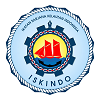Perbandingan Larutan NaCl dan K2CO3 Sebagai Media Pemisahan Densitas Mikroplastik Pada Sedimen Pantai Kondang Merak dan Pantai Goa Cina
Abstract
ABSTRAK
Salah satu tahapan dalam analisis mikroplastik adalah proses pemisahan partikel mikroplastik dari sampel untuk memudahkan proses identifikasi. Pada penelitian ini digunakan larutan NaCl dan K2CO3 yang memiliki densitas berbeda, yaitu masing-masing 1,18 g/cm3 dan 1,43 g/cm3. Larutan NaCl dan K2CO3 memiliki densitas yang lebih tinggi daripada rata-rata mikroplastik yang ditemukan (0.9-1.4 g/cm3), oleh karena itu kedua larutan ini dipilih dalam proses pemisahan densitas. Sampel yang digunakan adalah sampel sedimen Pantai Goa Cina dan Pantai Kondang Merak. Kedua pantai ini dipilih sebagai lokasi pengambilan sampel karena reputasinya sebagai pantai wisata dan berpotensi terhadap pencemaran mikroplastik. Tujuan penelitian ini adalah untuk membandingkan efektivitas penggunaan larutan NaCl dan K2CO3 dalam proses pemisahan densitas mikroplastik serta menganalisis hasil persentase jenis mikroplastik yang ditemukan. Secara keseluruhan terdapat 11 sampel yang terdiri dari lima sampel sedimen dari pantai Goa Cina dan enam sampel sedimen dari Pantai Kondang Merak. Sampel kemudian dikeringkan dan direndam pada masing-masing larutan NaCl dan K2CO3. Supernatant yang terbentuk dalam proses ekstraksi kemudian disaring menggunakan vacuum pump dan kertas whatman untuk diamati partikel mikroplastiknya menggunakan mikroskop. Kedua pantai menunjukkan hasil yang serupa, yaitu didominasi oleh mikroplastik berbentuk fiber. Hasil ekstraksi dengan menggunakan K2CO3 menunjukkan lebih banyak fragmen yang ditemukan dibandingkan dengan hasil ekstraksi dengan menggunakan NaCl. Mikroplastik dalam bentuk pellet hanya ditemukan pada ekstraksi menggunakan larutan K2CO3 pada sampel sedimen Pantai Kondang Merak. K2CO3 lebih mahal daripada NaCl, namun hasil ekstraksi menunjukkan bahwa mikroplastik yang terekstraksi dengan K2CO3 lebih banyak dibandingkan yang terekstraksi dengan NaCl.
Kata Kunci: Densitas, Fiber, Fragmen, Pencemaran, Wisata
ABSTRACT
One of the stages in microplastic analysis is the process of separating microplastic particles from the sample to facilitate the identification process. This study used NaCl and K2CO3 solutions used with the density of 1.18 g/cm3 and 1.43 g/cm3 respectively. NaCl and K2CO3 solutions have higher densities than the average microplastics (0.9-1.4 g/cm3) therefore these two solutions were used in the density separation process. The samples used were sediments from Goa Cina Beach and Kondang Merak Beach. Both beaches were chosen as sampling locations because of the reputation of their beauty which make it popular tourist destination. This study will serve as a reference to investigate the abundance of microplastics in the tourist beach of Malang. The purpose of this study is to compare the use of NaCl and K2CO3 solutions in the density separation process, starting from the cost required, materials needed, and the extraction results. Five samples were taken from Goa Cina beach and six samples from Kondang Merak Beach. The sediment samples taken then dried and immersed in the extraction solution, the supernatant formed in the extraction process was then filtered using a vacuum pump and wattman paper to be observed using a microscope. Both beaches showed similar results with fiber-shaped microplastics being the most common. The results of extraction using K2CO3 showed that more fragments were found than the results of extraction using NaCl. Microplastics in the form of pellets were only found in the extraction using K2CO3 solution in Kondang Merak Beach sediment samples. The price of K2CO3 is more expensive than NaCl, but the extraction results showed that microplastics extracted with K2CO3 are more abundant than those extracted with NaCl.
Keywords: Density, Fiber, Fragment, Pollution, Tourism
Full Text:
PDFReferences
Amin, B., Febriani, I. S., Nurrachmi, I., & Fauzi, M. (2021). The Occurrence and Distribution of Microplastic in Sediment of the Coastal Waters of Bengkalis Island Riau Province. IOP Conference Series: Earth and Environmental Science, 695(1), 012041. https://doi.org/10.1088/1755-1315/695/1/012041
Andrady, A. L. (2015). Persistence of Plastic Litter in the Oceans. In M. Bergmann, L. Gutow, & M. Klages (Eds.), Marine Anthropogenic Litter (pp. 57–72). Springer International Publishing. https://doi.org/10.1007/978-3-319-16510-3_3
Ayuningtyas, W. C., Yona, D., S, S. H. J., & Iranawati, F. (2019). Kelimpahan Mikroplastik Pada Perairan di Banyuurip, Gresik, Jawa Timur. JFMR-Journal of Fisheries and Marine Research, 3(1), 41–45. https://doi.org/10.21776/ub.jfmr.2019.003.01.5
Azizah, P., Ridlo, A., & Suryono, C. A. (2020). Mikroplastik pada Sedimen di Pantai Kartini Kabupaten Jepara Jawa Tengah. Journal of Marine Research, 9(3), 326–332. https://doi.org/10.14710/jmr.v9i3.28197
Bridson, J. H., Patel, M., Lewis, A., Gaw, S., & Parker, K. (2020). Microplastic contamination in Auckland (New Zealand) beach sediments. Marine Pollution Bulletin, 151, 110867. https://doi.org/10.1016/j.marpolbul.2019.110867
Browne, M. A., Crump, P., Niven, S. J., Teuten, E., Tonkin, A., Galloway, T., & Thompson, R. (2011). Accumulation of Microplastic on Shorelines Woldwide: Sources and Sinks. Environmental Science & Technology, 45(21), 9175–9179. https://doi.org/10.1021/es201811s
Cutroneo, L., Reboa, A., Geneselli, I., & Capello, M. (2021). Considerations on salts used for density separation in the extraction of microplastics from sediments. Marine Pollution Bulletin, 166, 112216. https://doi.org/10.1016/j.marpolbul.2021.112216
Duong, T. T., Le, P. T., Nguyen, T. N. H., Hoang, T. Q., Ngo, H. M., Doan, T. O., Le, T. P. Q., Bui, H. T., Bui, M. H., Trinh, V. T., Nguyen, T. L., Da Le, N., Vu, T. M., Tran, T. K. C., Ho, T. C., Phuong, N. N., & Strady, E. (2022). Selection of a density separation solution to study microplastics in tropical riverine sediment. Environmental Monitoring and Assessment, 194(2), 65. https://doi.org/10.1007/s10661-021-09664-0
Fritsch, B., Körner, A., Couasnon, T., Blukis, R., Taherkhani, M., Benning, L. G., Jank, M. P. M., Spiecker, E., & Hutzler, A. (2023). Tailoring the Acidity of Liquid Media with Ionizing Radiation: Rethinking the Acid–Base Correlation beyond pH. The Journal of Physical Chemistry Letters, 14(20), 4644–4651. https://doi.org/10.1021/acs.jpclett.3c00593
GESAMP, Kershaw, P., Turra, A., & Galgani, F. (2019). GESAMP. Guidelines for the Monitoring and Assessment of Plastic Litter in the Ocean. (IMO/FAO/UNESCO-IOC/UNIDO/WMO/IAEA/UN/UNEP/UNDP/ISA Joint Group of Experts on the Scientific Aspects of Marine Environmental Protection). Rep. Stud. GESAMP No. 99, 130p.
Gohla, J., Bračun, S., Gretschel, G., Koblmüller, S., Wagner, M., & Pacher, C. (2021). Potassium carbonate (K2CO3) – A cheap, non-toxic and high-density floating solution for microplastic isolation from beach sediments. Marine Pollution Bulletin, 170, 112618. https://doi.org/10.1016/j.marpolbul.2021.112618
Jemec, A., Horvat, P., Kunej, U., Bele, M., & Kržan, A. (2016). Uptake and effects of microplastic textile fibers on freshwater crustacean Daphnia magna. Environmental Pollution, 219, 201–209. https://doi.org/10.1016/j.envpol.2016.10.037
Mauludy, M. S., Yunanto, A., & Yona, D. (2019). Microplastic Abundances in the Sediment of Coastal Beaches in Badung, Bali. Jurnal Perikanan Universitas Gadjah Mada, 21(2), 73. https://doi.org/10.22146/jfs.45871
Periyasamy, A. P., & Tehrani-Bagha, A. (2022). A review on microplastic emission from textile materials and its reduction techniques. Polymer Degradation and Stability, 199, 109901. https://doi.org/10.1016/j.polymdegradstab.2022.109901
Prata, J. C., Da Costa, J. P., Duarte, A. C., & Rocha-Santos, T. (2019). Methods for sampling and detection of microplastics in water and sediment: A critical review. TrAC Trends in Analytical Chemistry, 110, 150–159. https://doi.org/10.1016/j.trac.2018.10.029
Radford, F., Zapata-Restrepo, L. M., Horton, A. A., Hudson, M. D., Shaw, P. J., & Williams, I. D. (2021). Developing a systematic method for extraction of microplastics in soils. Analytical Methods, 13(14), 1695–1705. https://doi.org/10.1039/D0AY02086A
Sarasita, D., Yunanto, A., & Yona, D. (2020). Kandungan Mikroplastik pada empat jenis ikan ekonomis penting di perairan Selat bali. Jurnal Iktiologi Indonesia, 20(1), 1–12.
Simamora, C. S. L., Warsidah, W., & Nurdiansyah, S. I. (2020). Identifikasi dan Kepadatan Mikroplastik pada Sedimen di Mempawah Mangrove Park (MMP) Kabupaten Mempawah, Kalimantan Barat. Jurnal Laut Khatulistiwa, 2(3), 96. https://doi.org/10.26418/lkuntan.v2i3.34828
Syahwandi, M., Rahmalia, W., Zahara, T. A., & Usman, T. (2019). Adsorpsi Asam Lemak Bebas Dalam Minyak Sawit Mentah Menggunakan Adsorben Abu Tandan Kosong Sawit. Indonesian Journal of Pure and Applied Chemistry, 2(3), 121. https://doi.org/10.26418/indonesian.v2i3.36894
Van Cauwenberghe, L., Devriese, L., Galgani, F., Robbens, J., & Janssen, C. R. (2015). Microplastics in sediments: A review of techniques, occurrence and effects. Marine Environmental Research, 111, 5–17. https://doi.org/10.1016/j.marenvres.2015.06.007
Yona, D., Sari, S. H. J., Iranawati, F., Bachri, S., & Ayuningtyas, W. C. (2019). Microplastics in the surface sediments from the eastern waters of Java Sea, Indonesia. F1000Research, 8, 98. https://doi.org/10.12688/f1000research.17103.1
Yona, D., Maharani, M. D., Cordova, M. R., Elvania, Y., & Dharmawan, I. W. E. (2020). Analisis Mikroplastik Di Insang Dan Saluran Pencernaan Ikan Karang Di Tiga Pulau Kecil Dan Terluar Papua, Indonesia: Kajian Awal. Jurnal Ilmu dan Teknologi Kelautan Tropis, 12(2), 497–507. https://doi.org/10.29244/jitkt.v12i2.25971
Yona, D., Zahran, F., Fuad, M. A. Z., Prananto, Y. P., & Harlyan, L. I. (2021). Mikroplastik di Perairan: Jenis, Metode Sampling, dan Analisis Laboratorium. Universitas Brawijaya Press. https://books.google.co.id/books?id=QIZTEAAAQBAJ
DOI: https://doi.org/10.21107/jk.v17i1.21898
Refbacks
- There are currently no refbacks.

This work is licensed under a Creative Commons Attribution 4.0 International License.

Jurnal Kelautan by Program Studi Ilmu Kelautan is licensed under a Creative Commons Attribution 4.0 International License.
Published by: Department of Marine Sciences, Trunojoyo University of Madura













